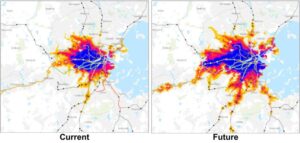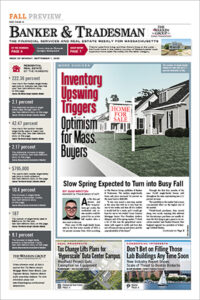
An analysis by A Better City and engineering firm AECOM shows the growth in what areas can reach a future West Station within 45 minutes if a rail link between the station and North Station is added. Image courtesy of A Better City
A multi-billion-dollar effort to rebuild and straighten the Mass. Pike as it passes through Allston could help spur economic growth 35 miles away in Worcester, in addition to the 11 million square feet of development it could spur in Boston, Central Massachusetts’ top business leader says.
And that could give the state a leg up on its latest attempt at securing the federal funding necessary for such an ambitious project.
Dozens of business leaders, community and transit advocates and top officials from Boston and the Healey administration gathered in downtown Boston Tuesday morning for a symposium convened by business-backed transit and planning advocacy group A Better City.
“I think it’s a huge opportunity, not only for the city of Boston but also for Central Massachusetts,” Tim Murray, CEO of the Worcester Regional Chamber of Commerce told the crowd. “I think even projecting out over a five- to 10-year period, as East-West Rail begins operation.”
As an example, the former lieutenant governor cited the impact a tripling of MBTA commuter rail service between Worcester and Boston’s South Station has had on the city’s downtown, spurring “several billion dollars’ worth of investment” around Worcester’s Union Station in recent years. That investment, he noted, includes “concentric circles” of housing and biomanufacturing projects.
And connecting Central Massachusetts to this new growth center, Murray said, along with the life science hubs in Cambridge’s Kendall Square and Boston’s Longwood Medical Area, via a new train station on the site and future rapid transit connections coming off of that would offer a significant boost to his region.
“It’s more for us to market for jobs and investment,” he said.
An August 2022 report by A Better City said the Allston I-90 rebuild and associated construction of a new “West Station” commuter rail and bus hub could generate at least 12,400 jobs and 11.17 million square feet of housing, lab, office, hotel and retail space over 20 years on what’s currently a former rail yard owned by Harvard University and a tangle of freeway offramps leading off Interstate 90 as it rises to a viaduct along the Charles River behind Boston University.
By straightening the highway, the project would create opportunities to reconnect neighborhoods north and south of the rail yard and open up the 100-acre, currently landlocked site to new, transit-oriented development that some in attendance Tuesday compared to “another Seaport District” or an even bigger growth opportunity than the Boston Landing area nearby.
The Boston Planning & Development Agency is soon to begin an 18-month planning study that will propose zoning and other rules for the area, BPDA Director Arthur Jemison told the crowd Tuesday. Harvard officials also announced over the weekend that they had landed $750 million in financing for its Enterprise Research Campus, a multi-building, 900,000-square-foot development just to the north to the Allston I-90 project site that’s widely seen as the first phase of its overall development ambitions for the new neighborhood.
But for this vision to become a reality, state officials will need to convince the infrastructure financiers at the federal Department of Transportation that Allston I-90 rebuild has a serious financing plan in place and a coherent design taking shape. After a years-long tug-of-war under the Baker administration, the state and community groups came together on the basic outlines of a design. But the last time Massachusetts went up to the plate for the project earlier this year, federal officials took a pass: the complicated process of assembling a local financing plan hadn’t taken place under Gov. Charlie Baker, and Gov. Maura Healey’s administration hadn’t been in office long enough to do the work, either.
Federal officials also dinged Massachusetts’ proposal for not showing it would generate significant economic growth, speakers at Tuesday’s event said, a perception A Better City and its allies say they hope to change.
Either way, the stakes are high.
“We have a year to get this right,” said Stacy Thompson, executive director of transit advocacy group LivableStreets, citing the Biden administration’s ambitious infrastructure plans under the Inflation Reduction Act. “If we don’t take this moment now, we’ve missed a generational opportunity. We don’t have another decade.”
When asked by an attendee if state legislators were eyeing any plans for the state’s contribution to the project, audience member and Belmont state Sen. Will Brownsberger demurred. But new MBTA and Massachusetts Department of Transportation general counsel Doug McGurrah said ideas like bonding against some future toll revenues were “on the table.”





